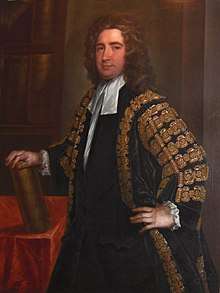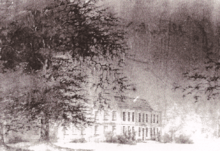Thomas Carter (1690–1763)
Thomas Carter PC (c. 1690 – 3 September 1763) was a politician, a member of parliament, Master of the Rolls in Ireland, Privy Councillor and Secretary of State for Ireland. He was "an able and intriguing man" – Horace Walpole, 4th Earl of Orford.
Thomas Carter | |
|---|---|
 Painting of Thomas Carter by Charles Jervas | |
| Master of the Rolls in Ireland | |
| Monarch | George II |
| Secretary of State | |
| Personal details | |
| Born | Thomas Carter c. 1690 Hollybrook, Dublin, Ireland |
| Died | 3 September 1763 Rathnally House, near Trim |
| Resting place | St Patrick's Cathedral, Trim |
| Nationality | Irish |
| Political party | Patriot Party |
| Spouse(s) | Mary Claxton c1700-1780 |
| Relations | (brothers-in-law) James Johnston Richard Parsons Robert Jocelyn (descendants) Frances Villiers Admiral John Carter General George Carter-Campbell Colonel Duncan Carter-Campbell of Possil |
| Children | Thomas, M.P. 1720- Henry Boyle 1726- Frances Twysden, later Johnston Susan Trotter Mary Carter |
| Residence | Castlemartin House, Co. Kildare and No. 9 Henrietta Street, Dublin |
| Alma mater | Trinity College, Dublin |
| Profession | Master of the Rolls in Ireland, Secretary of State |
Political career
Carter was Member of Parliament MP for Trim in County Meath, from 1719 to 1727. In 1727 he was returned as a member for Hillsborough, Dungarvan, and Lismore, but chose to sit for Hillsborough, and held the seat until 1761.[1]
The Carters were a political family. Thomas Carter, the first to live at Castlemartin which he acquired in 1729, was made Master of the Rolls in Ireland in 1731, which office he had continued to hold until 1754. He was a skilful and experienced parliamentarian and political organiser. A strong, if not often violent Whig, noted for his rudeness and his loathing of English ministerial interference in Irish affairs and his satirical lampooning of political opponents earned him the nickname "Vicious Carter".
During the late 1740s Carter became one of the leaders of the country of Ireland as a member of the Patriot party along with Henry Boyle, speaker of the Irish House of Commons and Anthony Malone, the Prime Sergeant.
He was made Master of the Rolls in 1731 but as one of the parliamentary managers employed by the Lord Lieutenant to ensure that the King's business was passed in the House of Commons, his actions were often maverick. Horace Walpole said of him that he had "Constantly fomented every discontent against the Lord Lieutenants in order to be bought off". Such behaviour was common in 18th century politics where interest was so often for sale. Quite content to "feather his own nest" Carter did not always help his colleagues.
The Money Bill dispute
Both the zenith and the nadir of Carter's career came during the Money Bill dispute of the 1750s. The crisis came in 1753–56 when the Chancellor of the Exchequer of Ireland, Henry Boyle, refused to hand over an Irish tax surplus to London.
As a result, Primate Stone Archbishop of Armagh, tried to reduce the influence of the leading parliamentary undertakers; Speaker Boyle, Anthony Malone and Thomas Carter. The archbishop tried to replace them with his own supporters, the Ponsonbys led by the Earl of Bessborough. Boyle, Malone and Carter whipped up popular support, turning the issue into a trial of strength between the Lord Lieutenant and the country or "Patriot" party. Boyle, helped by Carter's wickedly provocative tongue, began a whispering campaign against Primate Stone. There was a personal antagonism between Carter and Primate Stone as the latter had been instrumental in foiling Carter's attempts to obtain the reversion of his office of Master of the Rolls for his young unknown and inexperienced son.
The whole episode of the Money Bill dispute, the motives, intrigues, manoeuvrings and chicanery was wittily and ironically described by Edmund Sexton Pery, an eye-witness and MP for Wicklow town. His description is written in the form of a letter to the Duke of Bedford around the time he was appointed Lord Lieutenant in 1757.
The dispute became an oft-quoted precedent to the policy of the Irish Patriot Party of the 1780s.
Family
Thomas Carter was born in 1690, the son of Thomas Carter (1650–1726) and his wife born Margaret Houghton, of Robertstown, County Kildare. He was educated at Trinity College, Dublin and the King's Inns.
He married 12 October 1719 at St Anne's, Dublin, Mary Claxton, youngest daughter of Thomas Claxton of Dublin and Lucy Pearce, and so first-cousin of Edward Lovett Pearce who built them a magnificent house at No.9 Henrietta Street with the finest staircase hall in Dublin. They had two sons and three daughters. Their daughter Frances was mother of Frances, Lady Jersey. Their daughter Susan was grandmother of Elizabeth, Marchioness of Thomond.
Thomas Carter made significant contributions to farming and country pursuits, not sparing any expense to bring them to perfection. He imported the best breed of cattle.

He originally leased Castle Martin in the early 1730s as his country seat, and did not buy the house and that estate until 1761, just two years before he died while staying with his elder son, Thomas MP, at Rathnally House, Trim. Twelve days after his father's death[2] Thomas proceeded with his marriage to Anna Armytage, daughter of the Yorkshire baronet Sir Samuel Armytage, but they had just one child, Mary, later Mrs Skeffington Thompson, before young Thomas Carter MP himself died.
So Carter was succeeded at Castlemartin by his second son Henry Boyle Carter, named after his father's friend and political ally, Speaker Boyle. In 1750 Henry married Susanna Shaen, widow of James Wynne, daughter of Sir Arthur Shaen, 2nd baronet, and his Catholic wife Susanna Magan, by whom Henry had three sons and one daughter. (see Carter-Campbell of Possil). Carter's descendants continued to live at Castlemartin until they sold the estate to the Blackers in 1850.
Thomas Carter (1650–1726) M.P. father of Thomas Carter (1690–1763)
Thomas Carter the elder was obviously a very ambitious young man, he married firstly Margaret Houghton (c. 1660-1696) on 16 December 1681 at St. Audoen's Church, Dublin. During the revolution he served with distinction at Derry and the Boyne where according to Burke's Irish Landed Gentry (1850 edition) he secured books and writings belonging to James II of England. What happened to these papers is not known. He was elected as an MP to the Irish House of Commons and became Second Sergeant at Arms being returned first for Fethard and then for Portarlington.
He married secondly, Isabella, the dowager Countess Roscommon on 2 August 1702 by which marriage he acquired the extensive Roscommon estates in and around Trim. The Countess was born Isabella Boynton. They had no children and she died in 1721. Thomas Carter's father's seat was at Robertstown, County Meath.
References
- Aronsson, Peter. "Carter, Thomas (1690–1763), politician". Oxford Dictionary of National Biography (online ed.). Oxford University Press. doi:10.1093/ref:odnb/39755. (Subscription or UK public library membership required.)
- The puzzling behavior of (cattle-breeder) father and son might be explained if the, evidently kindly regarded, younger Thomas, MP, (dead by 1766 when his widow remarried) had been crippled in his youth by tuberculosis and forbidden by his father to marry for fear of passing on the then mysterious bovine-sourced infection. A male heir (not the heiress that resulted) may have had a good case to obtain his grandfather's estates.
- Evans, Richard K (2007). The Ancestry of Diana Princess of Wales; for Twelve Generations. New England Historic Genealogical Society Boston Massachusetts. pp. 91, 143 (Thomas Carter). ISBN 0-88082-208-2.
- Henry Colin Gray Matthew, Brian Howard Harrison, British Academy. Oxford dictionary of national biography. ISBN 0-19-861360-1.CS1 maint: multiple names: authors list (link)